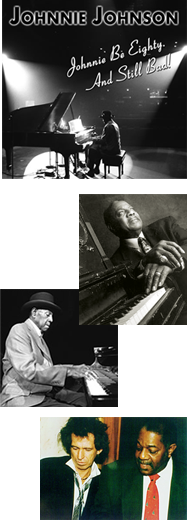Johnnie Johnson
1924-2005, Fairmont, Marion County
Johnnie Johnson is regarded as one of the architects of rock ’n’ roll piano. For nearly three decades, he laid down a solid rhythmic pulse behind Chuck Berry’s down-home rockers. And, in doing so, he helped provide the building blocks for an entirely new genre of music.
Johnson began playing piano in West Virginia at age five. While serving in the Marine Corps he joined a servicemen’s jazz orchestra called The Barracudas. Johnson was posthumously awarded the Congressional Gold Medal for breaking racial barriers in the military. Following his stint in the service, Johnson moved to Detroit and then Chicago, where he sat in with blues artists including Muddy Waters and Little Walter.
By 1952, Johnson had settled in St. Louis where he put together The Sir John Trio. On New Year’s Eve 1953, Johnson asked Berry to fill in when his saxophonist suffered a stroke. Soon, the charismatic Berry was the band’s songwriter, singer and guitarist. The group became the house band at the Cosmopolitan Club in East St. Louis where Johnson’s piano style helped shape Berry’s guitar playing. When Johnson realized people were coming to see Berry, the band was renamed the Chuck Berry Trio.
A reworking of the Bob Wills western swing classic “Ida Red” landed Berry a deal with Chess. His first single was “Maybellene.” The B-side was “Wee Wee Hours,” an instrumental that had been in Johnson’s repertoire for years, with some quick lyrics penned by Berry.
Over the next two decades, the two collaborated on many of Berry’s hits including “School Days,” “Roll Over Beethoven,” “Carol” and “Nadine.” The song “Johnny B. Goode” was reportedly a tribute to Johnson, with the title referring to Johnson’s behavior when he was drinking. Berry and Johnson played and toured together on-and-off through 1973.
After parting ways with Berry, Johnson led Albert King’s rhythm section during King’s most musically significant period. Johnson was a key player in the St. Louis blues scene in the early- and mid-’80s where he was a member of The Sounds of The City and played with many of the city’s top blues artists.
Johnson received little recognition until the release of Hail! Hail! Rock ’n’ Roll, the 1987 concert documentary which celebrated Berry’s 60th birthday. That attention encouraged Johnson – who was working as a bus driver in St. Louis – to return to music. That same year, he recorded Blue Hand Johnnie, his first solo release. In 1992, Johnnie B. Bad featured cameos by guitarists Keith Richards, Eric Clapton and former NRBQ co-founder/guitarist Steve Ferguson.
Clapton hired him as a featured artist for his annual Royal Albert Hall blues shows while Keith Richards tapped him for his Xpensive Winos group. In 1996 and ’97, Johnson toured with Grateful Dead guitarist Bob Weir’s band Ratdog.
Johnson’s biography, Father of Rock and Roll: The Story of Johnnie B. Goode Johnson, by Travis Fitzpatrick was published in 1999 and he received a Pioneer Award from the Rhythm and Blues Foundation in 2000.
Thanks in part to the efforts of fans including Keith Richards, Johnson was inducted into the Rock and Roll Hall of Fame in 2001.
Johnson died in St. Louis on April 13, 2005.
